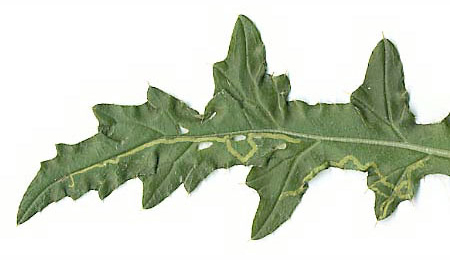|
||||||
|
CNICUS. Blessed Thistle. [Asteraceae] |
|
Only one species of Cnicus is recorded in Britain, the introduced Blessed Thistle (C. benedictus). Three British miners are recorded on Cnicus.
A key to the European miners recorded on Cnicus is provided in Bladmineerders van Europa. |
Key for the identification of the known mines of British |
1a > Leaf-miner: A distinctive mine primarily above mid-rib, with irregular short lateral offshoots into leaf blade. Pupation external (Spencer, 1972: 51 (fig. 172), 55; Spencer, 1976: 270, 271 (fig. 486)). Branched, whitish, upper-surface corridor; main axis overlying the midrib; side branches overlying the main lateral veins. (In Campanula and Phyteuma the mine is much less branched, sometimes nothing more than a corridor on top of the midrib). Frass in rather long strings. Usually the mines begins as a long and narrow, shallow, tortuous lower-surface corridor that ends upon the midrib but otherwise is not associated with the leaf venation. Often this initial corridor is filled with callus, and then even less conspicuous. Pupation outside the mine. A linear mine on the upper surface, usually following the midrib and showing side branches along the veins. The frass is in strings. |
|
Liriomyza strigata (Meigen, 1830) [Diptera: Agromyzidae]. |
1b > Leaf-miner: Mine linear, whitish, both upper and lower surface. Pupation internal, at the end of the mine with the anterior spiracles projecting through the epidermis (Spencer, 1976: 433). Upper-surface, less often lower-surface corridor. Frass in isolated grains. Pupation within the mine, in a, usually lower-surface, pupal chamber. A long whitish upper surface corridor, which eventually goes lower surface. |
|
Chromatomyia horticola (Goureau, 1851) [Diptera: Agromyzidae]. |
1c > Leaf-miner: Long narrow interparenchymal mine, greenish. Pupation in leaf at end of mine (Spencer, 1976: 503 (fig. 880)). Unusually long, interparenchymatous, therefore yellowish corridor that remains of equal width throughout its length. (In some plants with thin leaves, like Cirsium oleraceum the mines are not interparechymatous but either full-depth or alternating upper- and lower-surface). The mine makes few curves, and hardly any u-turn, causing the mine to usually occupy the entire length of a leaf. Frass in two rows of grains along the sides. Pupation within the mine, in a lower-surface puparial chamber; the anterior spiracles penetrate the epidermis. |
 Mines of Phytomyza spinaciae on Cirsium arvense Image: © Willem Ellis (Bladmineerders van Europa) |
|
Phytomyza spinaciae Hendel, 1928 [Diptera: Agromyzidae]. |
| Last updated 02-Jul-2019 Brian Pitkin | ||
